In less than a decade, the video gaming industry has undergone a radical transformation. The web3 gaming revolution is now in full swing, with developers harnessing the power of blockchain technology to create new experiences that are redefining what it means to game.
And while this new model holds a great deal of promise, this new paradigm puts the spotlight on the great challenge that is designing Sustainable Game Economies.
“Game Economy is the interconnection of ALL exchanges in a game and the role of Game Economy is to design, maintain, balance and protect those systems that govern players’ interactions and exchanges.” Glyn Fairweather, Game Design Analyst, at Fundamentally Games
If it’s not wrong to understand that Sustainable Game Economy looks into the financial prospect of a game – its monetization model and how much revenue it can generate for your studio – for a video game to be commercially successful, it is also necessary to take into account all variables available within your project. Game economy should be an integral part of your game, and that goes beyond the spectrum of your in-game market or the fiscality of your project.
Furthermore, and to quote Edward Castronova, “the economies of games, as a matter of fact, are not just functioning like a genuine economy: they are a genuine economy“. And if the perception of a good economy is heavily tied to how much cash we are able to spend on commodities, economies are in fact made up of all kinds of different factors affecting, in one way or another, every experience we have in life.
Just like real-world economies, games are made of tons of different parts and interconnected systems. All those game loops and mechanics structure different players’ interactions and exchanges within your game and with them, there are a lot of places where things could go wrong.
That is why we’ve created this manifesto, where we intend to use the analogy of real-life macroeconomics to game economies to demystify various economic concepts, so that game developers can gain a deeper comprehension of the working sustainable economies, laying down the foundations one needs to create successful games.
Table of contents:
- The One Goal of All Economy Design: Success
- The Three Pillars of Good Economy Design
- Best Practices for Economy Management
- Conclusion
1. The One Goal of All Economy Design: Success.
Building games requires countless hours and resources. Game studios do it because they love to see happy people playing their games, and they also want to make money. Fortunately, these motives overlap, and they also overlap with the interests of players, members, investors, and employees. As a result, we believe that the goal of all Economy Design is to help build games that succeed.
What does this mean?
Provide value to players
Economic history tells us that an economy cannot prosper if its users are dissatisfied. Because of this, in our opinion, no game will be successful unless it offers players something of value. If it’s a game, it has to be fun, and your economy should never block it.
In regards to Blockchain games, it’s also worth noting that in the absence of the fun factor, games have a higher chance of collapse – the earning promise aspect of your game should not take precedence, and its gameplay must stand on its own, otherwise it’s just an investment vehicle, not a game – that is why, we advise against mechanics that either draw users into something that is not valuable, or that interfere with other content in the game that has value. We seek to avoid damaging the fun wherever possible.
Economic problems can cause entire projects to collapse
Additionally, prior experiences have demonstrated that economic issues can make players lose faith in the developers because they will assume -fairly or unjustly- that a company that can’t manage its economy won’t be able to produce long-term value in terms of enjoyment, utility, or profit.
As an example, in 2013, Gaia Online, released Flynn’s Booty, a gold generator that led to inflation within its virtual world economy, things got so bad that players not only demanded to remove the generator but to fire the CEO, Schofield, and Jason Loia, COO. Eventually, after many of the game’s users departed to other virtual worlds, the studio launched special events that would lead to the drainage of gold, but the game could simply not re-establish its popularity again.
Machinations always looks to the sustainable vitality of the entire game project, through the long-run health of the world’s economy.
2. The Three Pillars of Good Economy Design
Sustainable economies have three key features that game designers should look for in their designs. Individually, each pillar is necessary but not sufficient for a healthy economy. Economic health requires all three.
I. Currency Stability
Currency stability should be the true target of currency design.
Games typically have one or more currencies – another word for it would be money or token. A currency is defined as an item that has no use in and of itself, but it is spent to obtain other items that do have a use.
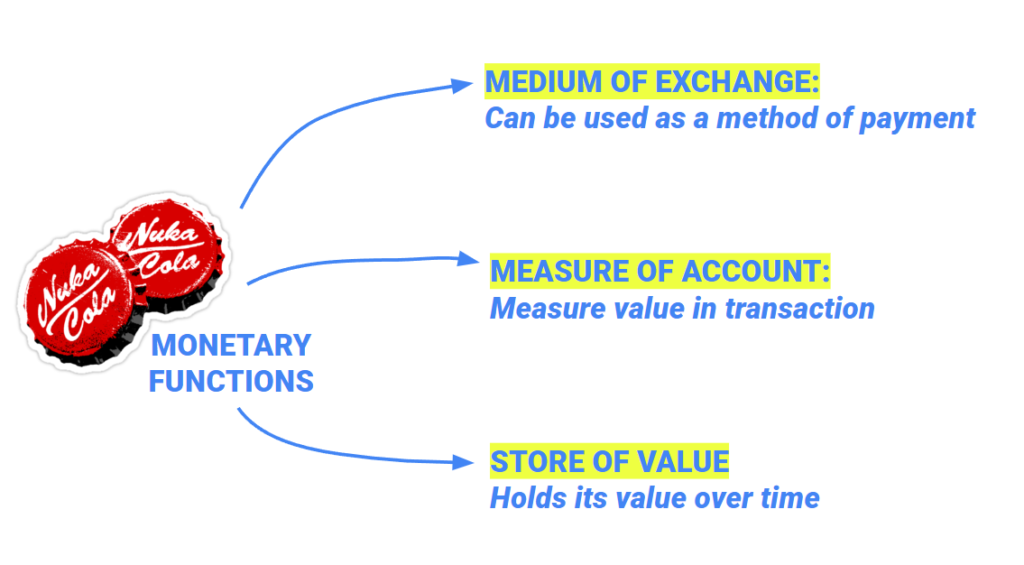
The core issue when designing economy is not inflation or deflation per se, but rather the failure of its currencies to keep within certain bounds of value. Wildly rising, falling, or fluctuating currencies prevent almost any player economic activity from proceeding smoothly.
Thus, currency stability, rather than inflation or deflation, should be the true target of currency design so that as a medium of exchange currency can serve as a unit of account and sustain economic planning.
Machinations uses the word inflation to talk about one thing and one thing only: the decline in the purchasing power of a currency. What this means is, imagine there is a market basket of goods in the economy. It contains a very wide variety of goods, almost everything that this economy can provide. On any given day, this market basket will cost a certain amount of currency. If on some later day it costs more, then we say that the currency has lost value. Other words would be depreciated or inflated. Whenever it requires more money to buy the same basket of goods, inflation has occurred.
Inflation is by far the most common worry in modern virtual currency design. We have not named this pillar “sustaining currency value” however, because developers should be aware that currency value can go in the other direction, and that would also be a serious worry.
Over the course of gaming history, there have been a number of famous examples of hyperinflation that have reduced a game’s primary currency to the point of uselessness:
Diablo II: Famously, gold became so abundant in the game that players abandoned it and started trading in the common, but useful item, the Stone of Jordan. The Stone entirely replaced the game’s primary currency, and in-game items were priced in numbers of Stones of Jordan.
Axie Infinity saw its momentum fading last year as its currency, the SLP trading value kept falling. Mainly due to improper burn mechanics and imbalance of issuing its currency, the game saw an overload of SLP. Without means to destroy the token, Axie suffered from inflation resulting in fewer earnings for players and thus failing to incentivize new players to enter the game.
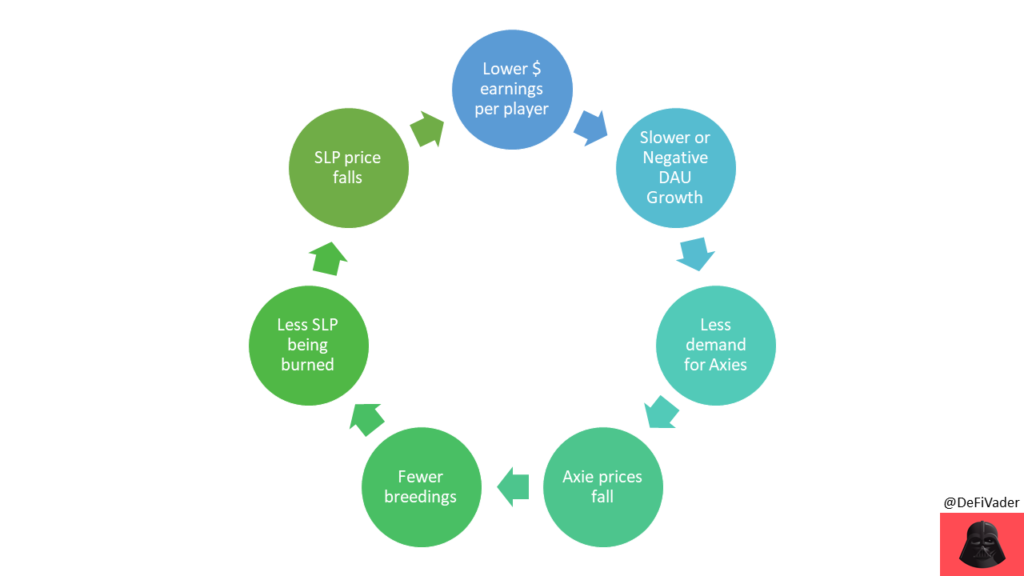
The doom case scenario for Axie Infininty (source DefiVader)
A stable currency does not have any of these problems. Its value changes only slowly if at all, and rises and falls rather than going in one direction exclusively. Secondly, players use it. And finally, because of the first two, it has a sustained positive price in trades with other currencies.
Key Points:
Control all the rates of the release of wealth:
Money supply growth is the primary lever for achieving currency stability: pay attention to the changes in the number of players, and control the growth rate of players and the rate of money supply.
Control the rates of draining and destruction of assets:
Implement mechanisms to control inflation by the burning of assets (money consumption): token burning helps with stabilizing the value of a coin and minimizing the risk of potential price inflation.
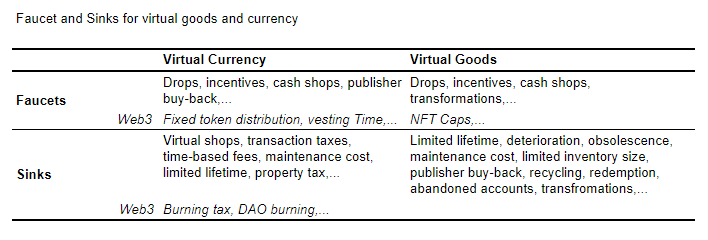
Think about Eve online: player conflict is the engine that drives EVE’s economy and gameplay, and is what motivates players to spend large amount of ISKs, the Eve Online in-game currency, so as to invest in the ships, the materials, the rights to mineral extraction from far-away asteroids, and on everything one needs to build.
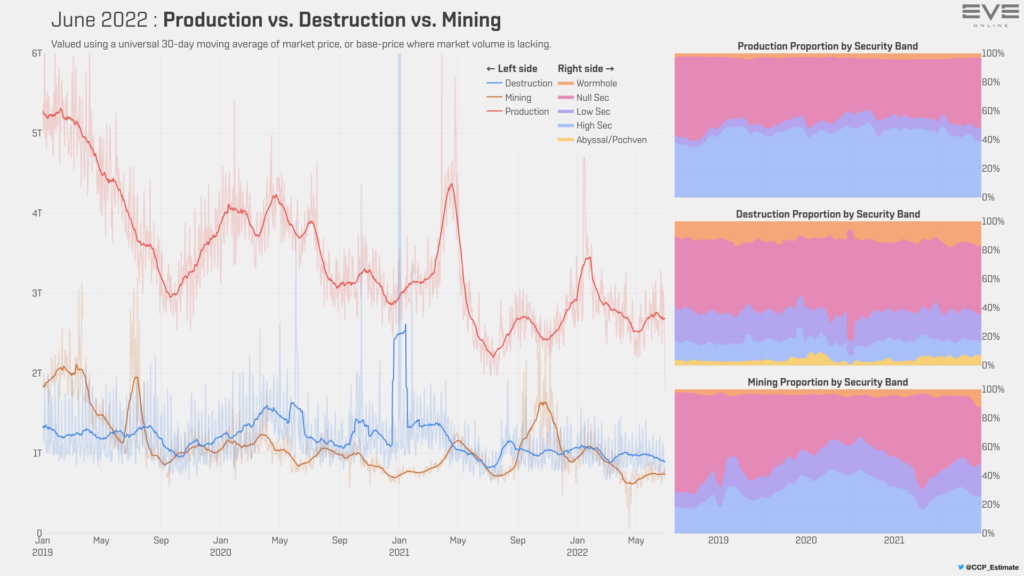
Tracking Production vs. Destruction in Eve Online. (Source CCP)
II. Price Rationality
The prices of goods should match what the players want them to be.
A system for establishing fair prices and figuring out how much everything in the game is worth is necessary for a well-balanced economy design. An item should be expensive if it is thought to be very valuable. Things that are supposed to have no value ought to be priced at or close to zero.
Even if the currency is sound, if the price system is somehow inverted, the economy is showing signs of breakage and may fail, frustrating both players and developers with inefficient trades within the economy.
As a consequence, when prices are set arbitrarily, without any responsiveness to the demand for the good, the actual value in exchange may be higher or lower than the price. If the exchange value is higher, there will be excess demand: shortage. If the exchange value is lower, there will be insufficient demand: surplus.
Get your prices right: simulate your economy
Finally, the problem of launch pricing is particularly thorny. The most common question Machinations receives is, “What should be the starting price of my good?” In the absence of an existing market, prior to launch, one can only guess.
That is another reason why simulations of economies are necessary. Simulations are the only way to get a sense of how prices will come together in an entire system of value.
III. Proper Allocation
The allocation function of an economy refers to the way an economic system distributes goods to people.
A successful economy distributes the right goods to the right people and does it in a way that seems reasonable and fair to everyone involved.
When it comes to games, a fair allocation system only distributes highly valuable treasures to players who have earned them through a combination of skill, time, and effort. From the standpoint of a developer, allocation is essential to achieving the majority of economic objectives.
Sometimes in crypto projects, a number of tokens are generated and distributed amongs some exclusive addresses before going public (pre-mining). This may generate an unfair launch where unfair distribution of tokens and NFT items could make gaming communities a non-starter. It could also leaves the game’s player with fewer rewards to win through active gameplay and if the game turns out to be a success, early investors, who may not want to play the game directly, could collect profits, which would throw off the game’s economy balance in the process.
Design a fair and just allocation System
The allocation process will need to be fair and just. They may sound like nebulous categories, but economic history shows that when people believe a system is unfair, pressure and crisis often result. This consideration is ambiguous not because it is unnecessary but because there are strong disagreements among people regarding what constitutes a “fair” system.
Research shows that users of a virtual economy will consider it fair if it has:
- Equality of Opportunity – players should start a game with the same resources, and/or
- Equality of Return – players who put in an equal amount of work, skill, and/or time should get the same return.
In technical terms, we are talking about equal endowments and equal rates of return.
There are difficult trade-offs between fairness and the value of the economy. For one thing, a perfectly fair economy is also perfectly boring. Some amount of randomness and optimization / exploit opportunity is necessary for a world to seem deep and interesting.
Moreover, the opportunity for excess profit is important for economic growth. Humans will not create new things and develop new patterns unless they perceive that there is a large return for being the first to do so. Thus, whether the economy is intended for the fun or the profit of its users, it cannot and should not be mechanically and absolutely equal in all respects.
Move from uncertainty to risk
The randomness observed in virtual economies is of two types: risk is the randomness in a die roll. We know what the probabilities are, but we do not know the outcome.
The other type of randomness is uncertainty. Uncertainty is a random situation where the probabilities are not known and it is much harder to deal with uncertainty than with risk. Facing risk, one can develop rational strategies for dealing with it. With uncertainty, no one has any idea what will happen, making rational preparation impossible.
The coronavirus pandemic of 2020 is an illustration of decision-making under uncertainty. When the pandemic initially began, we did not know the probability of being ill, nor did we know the percentages of dying if we did get ill. As long as there is ambiguity regarding the magnitude and duration of a pandemic, threats to economic and social activities pertain. By taming the uncertainity and quantifying the risk using probabilities as more reliable data came in, the Covid-19 pandemic became a much more constrained problem.
The work of Machinations can be viewed as assisting companies to move from uncertainty to risk. Designers can use our analysis to put probabilities to various events. Even though Event X is still impossible to predict, Event Y is likely, and Event Z is unlikely, so a company facing Event Possibilities X, Y, and Z is better off knowing this. Focusing on preparations is made easier for studios by reducing the range of uncertainties.
Simulating different player choices, play styles and manipulating randomness to simulate different player responses with Machinations helps developers to look at how players might approach your game.
Identify areas of unemployment
Employment is the selling of one’s own labor, and is by far the most important form of selling that exists in a virtual economic setting. Where real economies give most people jobs that offer little meaning or importance, virtual economies employ people in a wide range of exciting, important tasks, such as, saving the princess from the dragon, running a huge amusement park, or conquering the entire galaxy.
Other types of selling are also significant. Users who make an item that is intended for profitable resale need to have a market where such resale is indeed possible and profitable. For instance, people who stake resources need to get a return, and people who acquire NFTs need to have a reasonable prospect that the NFTs will be worth something later.
As a result, the employment component of the economy is crucial to its acceptance. Determining where player time or other resources are being wasted can help game designers identify tedious or otherwise unsatisfying mechanics (grinding) within their economy.
3. Best Practices for Economy Management.
1. All Knowledge Comes From Data
It takes data to manage an economy well. Aesthetic evaluations like “is my game fun?” are not applicable to economic health. It is a game state that is quantified by particular statistics. The economy is in good shape when those statistics fall within reasonable bounds or are moving in a reasonable direction. When data exceeds acceptable bounds, the economy is not in good shape. Monitoring economies and raising alarms when a number enters the danger range are part of economic management.
2. Standard Economic Metrics
Because every economy is different, there will be a different set of metrics to monitor. We will, however, make a few recommendations for common metrics that are crucial for every economy. After including these common statistics, Machinations advises game developers to add metrics that are specifically significant to their economy.
A. Price Index
A price index is the cost of a bundle of goods. It is the only reliable way to track inflation which, as explained above, defines currency stability.
The price index tracks how much this standard basket costs over time. The crucial thing is that the contents of the basket do not change. Thus, the change in the cost of the basket can be due to one thing and one thing only: prices. If the price of the basket goes up, it means that the currency has lost value: Inflation. If the price goes down, the currency has gained value: Deflation.
B. Production Index
In order to tell how much economic activity is going on, developers need to observe the flow of new goods into the economy. In the real world, this is called ‘gross domestic product.’ Declines in production indicate that people are not using the economy. In a virtual economy, this means that they are putting their labor/time elsewhere. Total product is the key measure of economic engagement.
Price and production indices can be created for subsets of the economy. This allows developers to track the health of different sectors.
This same technique can be used to build a trade index, where the basket quantities are not the total number of goods produced but rather the number traded.
C. Money Supply
The total amount of currency determines the rate of inflation. If the amount of money is going up faster than the production of new goods, inflation will occur. Therefore, money supply growth is the primary lever for achieving currency stability.
D. Capacity Usage
At any given time, an economy has a fixed capacity for production. This is rarely achieved in practice because some fraction of resources are standing idle. For instance, a factory might stand empty because it has just been sold and the new owner has not started to use it.
Economists measure idle capacity directly as the amount of a resource that is being used as a percentage of the total amount that could be used. That is why unemployment is reported as a rate: it is the fraction of the labor force that is available for employment but is not being utilized.
Every game will have different capacities to be watched, but all games should observe some metric of unemployment. This will be a lack of user engagement in a mechanic that is supposed to translate their time into new economic goods.
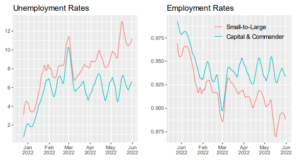
Ships Capacity Usage in Star Atlas. (Source: ATMTA, Inc. Economics Department)
E. Wages
Parallel to the above, the value of production per hour of user “work” should also be followed. This can also be broken down by sectors and occupations.
F. Inventories
Things like wages and production are flows: They are measured in time units. Stocks, which are snapshots at a point in time, are also important metrics. The most significant of these is inventory. Inventory is the total value of goods that are available for use at a point in time.
In an RPG, a player inventory will have so and so many pieces of cloth, so many bars of copper, so many swords, and so on. The total value of such goods in stock is given by the combined cost of all the goods.
Inventory growth is typically seen as a problem. It means that the economy is making more goods than users need. In a game context, it basically means that the economy is too easy, and not challenging.
On the other hand, players enjoy accumulating wealth. Like many other terms we have used, wealth has a specific definition: It is the value of a user’s inventory, plus the amount of currency owned. Total user wealth is the money supply plus inventories.
As with anything, inventories and wealth can be broken down by sector and user type. This allows the tracking of total NFT inventories, for example.
A list like this could be extended indefinitely, however, at some point the specific numbers to be tracked will depend on the unique features of the economy. Some developers need to see the exchange rate of their currency against others, but not all, and this could be said of any number of trackable metrics. Therefore, we keep the list short and move on to controls for the economy.
4. Design the Database
Early in the development process, tools for managing the economy should be designed. It is best to avoid taking a hasty approach, which is all too common today when the majority of game databases are a nearly unintended side effect of the code. For managing the economy, the information gathered in this way is frequently useless.
An example from the early days: In the mid-2000s, EverQuest handed 6 months of transaction data to a team of academics. The academics needed two years and a university supercomputer to massage the data into something that could be analyzed. Even today, major companies have teams of data analysts whose entire job is to write SQL queries to pull useful data out of the morass of variables that have been spit out almost randomly by the game loop.
It is far better to plan an economic management database early. If done well, the data can be presented to developers in the form of a dashboard, with simple levers and dials for adjusting parameters on the fly.
4. Implement Control Points
With the exception of currency, there are no common or standard dials and levers that can be recommended for a virtual economy. Each economy is unique. However, it is important for developers to play ahead and put the right controls into the system early.
A good economy control will be one that can be used quickly in response to a rapid change in metrics. Its effects are clear and well-known in advance. The effects are targeted specifically to one metric: If metric X suddenly rises, increase dial Y, and X will fall again. Metrics and controls should be designed so that they are easy to observe and easy to use.
In the ideal case, a response control can be automatic. An auction value percentage fee is an automatic currency stabilizer. When the total value of auctions rises – possibly indicating inflation – the fee takes more money out of the economy. It automatically reduces money supply when a money supply reduction is indicated.
Control Currency Inflow
Comparing flows A (inflow) and B (outflow) we can determine wheter stock S is growing or diminishing. The same approach can be used to examine changes in stocks of money and goods held in various parts of an economy.
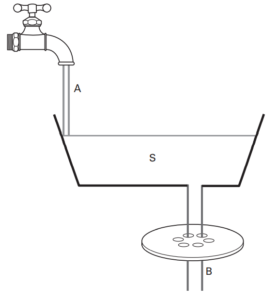
Source: Edward Castronova, Virtual Economies, Design and Analysis
Conclusion
Well-designed game economy looks at exchanges, putting their users’ resources to good use, with a reward system that gets the right goods into the hands of the right people. With a proper allocation system, combined with price rationality and currency stability you will provide the right amount of friction to your players, giving them a reason to play and engage with your game, thus making your project successful.
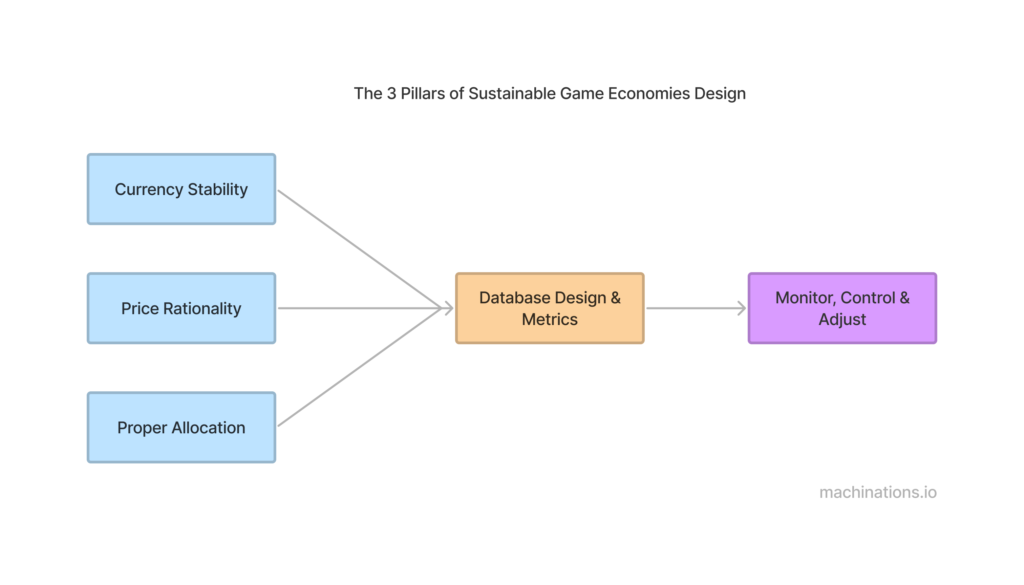
Building upon the publication of this Manifesto; we will publish in a subsequent chapter our guidebook on How To Operate Sustainable Game Economy – The Live-Ops Pillars. Stay Tuned!
Webinar Recording: join us for a talk on sustainable economies design
This Manifesto results from numerous exchanges between our team and Professor Edward Castronova, who advises Machinations on Economies. Continuing our vision of a world of healthy and long-lasting game economies, Castronova shares his insights on how to design healthy game economies by setting metrics and control points that matter, as well as how to build data-driven economy governance.

